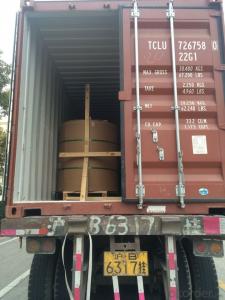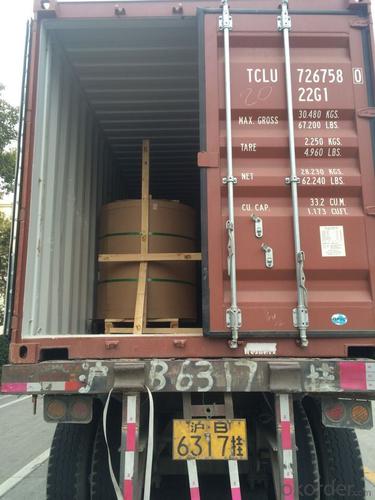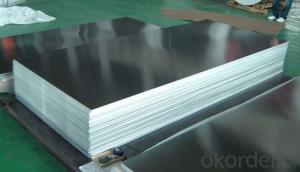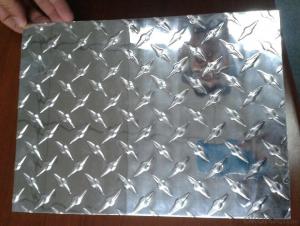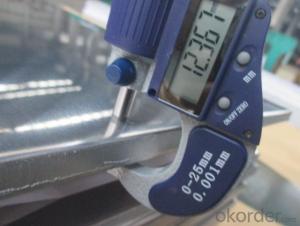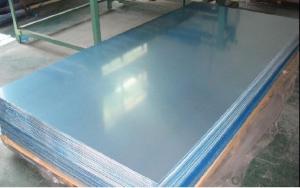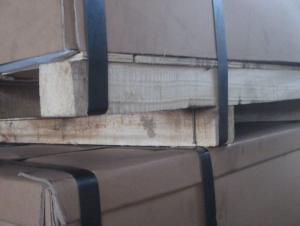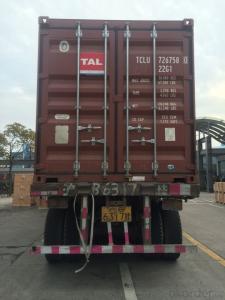Aluminum Foil Sheets - Aluminium Checkered Plate with Best Stocks Price in Our Warehouse
- Loading Port:
- Shanghai
- Payment Terms:
- TT OR LC
- Min Order Qty:
- 3 m.t.
- Supply Capability:
- 5000 m.t./month
OKorder Service Pledge
OKorder Financial Service
You Might Also Like
Specification
1.Structure of Product Description
hot rolled and cold drawn and cold rolled aluminum sheet is widely used in the field of construction field and decoration field, etc.
There are 3000 series, 6000 series,7000series, 8000 series, etc. The detailed grade are as follows: 1010,1100, 2024, 3003, 3105, 5052,5754,6061,6063,8011, etc.
The temper is include H14, H22, H24, H44,O, H112, H114,etc.
2. Main features of the product
a.Competitive price
c. Shortest service.
3. Image.
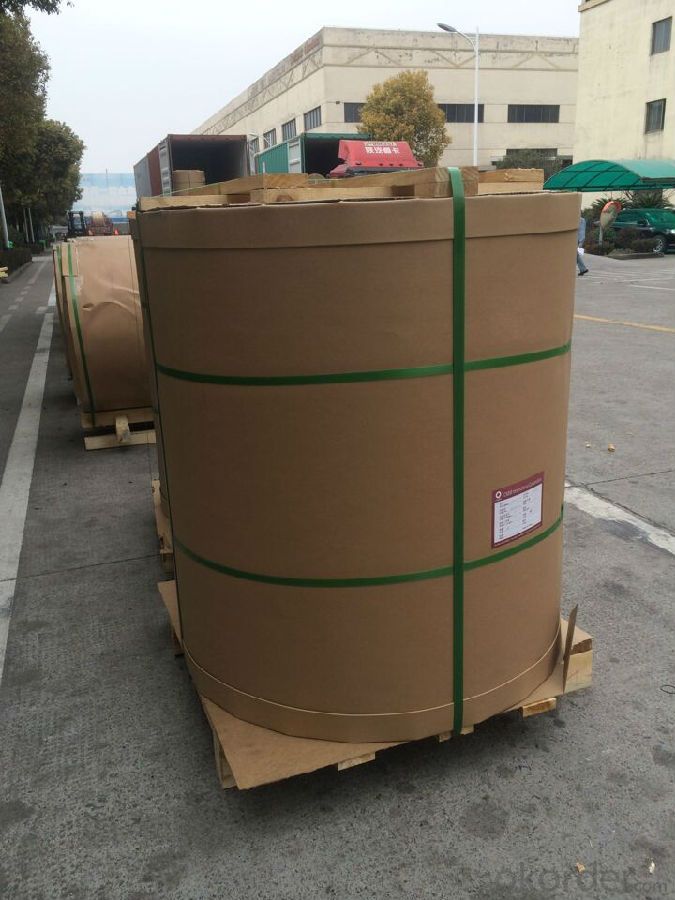
4. Product detailed sizes:
1000mm*2000mm,1220mm*2440mm,1500mm*3000mm,1219mm*2438mm, etc.
5. FAQ:
What is the quality standard?
---Usually our standard is GB3880-2006 or others.
What is the width range?
---It is from 100mm to 2500mm, etc.
What is the length range:
---It is from 400mm to 6000mm, etc.
What is the MOQ for your products yet?
---Normally it is around 12 tons/each size.
How many tons did you export in one year?
---Normally it is around 6000 tons totally.
Where is your client from?
---Normally it is from SRI LANKA,Saudi Arabia, England,Turkey,etc.
What is your mainly products?
---Normally they are aluminum sheet,big-5-bar aluminium checkered sheet,small-5-barmirror finish aluminium sheet, aluminum casting coil, etc.
- Q: How are aluminum sheets typically packaged for shipping?
- Aluminum sheets are typically packaged for shipping by being stacked together and secured with straps or bands. They may also be placed in crates or on pallets to provide additional protection during transport.
- Q: What are the different types of surface treatments available for architectural aluminum sheets?
- There are several types of surface treatments available for architectural aluminum sheets, including anodizing, powder coating, and PVDF coating. Anodizing involves creating a protective oxide layer on the surface of the aluminum, providing enhanced corrosion resistance and durability. Powder coating involves applying a dry powder to the surface of the aluminum and then curing it with heat, resulting in a durable and decorative finish. PVDF coating, also known as Kynar coating, is a type of liquid coating that provides excellent weather resistance and color retention. These surface treatments can enhance the appearance and performance of architectural aluminum sheets for various applications.
- Q: Do 101 aluminum sheets have any specific anti-corrosion properties?
- Yes, 101 aluminum sheets possess specific anti-corrosion properties. This aluminum alloy contains a small amount of iron and silicon, which enhances its resistance to corrosion. Additionally, the formation of a protective oxide layer on the surface of 101 aluminum sheets provides extra protection against corrosion.
- Q: Are aluminum sheets suitable for food preparation surfaces?
- Aluminum sheets are indeed suitable for food preparation surfaces. They are a lightweight and durable option extensively utilized in the food industry. Being non-toxic and non-reactive, aluminum does not pose any risk of releasing harmful chemicals upon contact with food. Moreover, aluminum sheets are highly convenient to clean and maintain, making them a preferred choice for both commercial and home kitchens. Furthermore, aluminum boasts excellent heat conductivity, ensuring even cooking and baking. Nevertheless, it is worth mentioning that aluminum may react with acidic or salty foods, resulting in a metallic taste. To prevent this, it is advisable to place a layer of parchment paper or a silicone baking mat as a barrier between the aluminum sheet and the food.
- Q: Which are better? I currently have steel (kinda ugly) rims on my Chevy Blazer right now, and my roommate has some aluminum alloy rims that will fit that he wants to sell me. He hates my steel rims so much that he's willing to sell me the alloy ones for $100.Should I take it? Or just stick with my steel ones?
- Steel Vs Alloy Wheels
- Q: Are aluminum sheets suitable for soundproofing applications?
- Yes, aluminum sheets can be suitable for soundproofing applications. Aluminum has good sound-blocking properties and can help reduce noise transmission when used in soundproofing applications. It is a lightweight material that can be easily installed as barriers or panels to create a sound barrier between different areas or to isolate specific equipment or machinery. Additionally, aluminum sheets can be used in combination with other soundproofing materials, such as foam or rubber, to enhance their soundproofing capabilities. However, it is important to note that the thickness and density of the aluminum sheets will play a significant role in determining their effectiveness for soundproofing. Thicker and denser aluminum sheets will provide better sound insulation compared to thinner ones. Additionally, other factors such as the design, construction, and installation of the soundproofing system will also impact its overall effectiveness in reducing noise.
- Q: Can aluminum sheets be used for food packaging?
- Yes, aluminum sheets can be used for food packaging. Aluminum is a safe and widely used material in the food industry due to its excellent barrier properties, resistance to moisture, and ability to maintain product freshness.
- Q: Can aluminum sheets be reused or recycled after their initial use?
- <p>Yes, aluminum sheets can be recycled again after use. Aluminum is one of the most recycled materials globally due to its low cost of recycling and its ability to retain its properties even after multiple recycling processes. Recycling aluminum saves energy compared to producing new aluminum from raw materials, and it helps reduce waste in landfills.</p>
- Q: Can 101 aluminum sheets be recycled?
- Certainly, it is possible to recycle 101 aluminum sheets. Aluminum possesses a remarkable recyclability, boasting an impressively efficient recycling procedure. Through the act of recycling aluminum sheets, we not only preserve valuable resources but also conserve energy and diminish greenhouse gas emissions. Additionally, recycling aluminum aids in the reduction of landfill waste and curtails the necessity for fresh aluminum ore mining. Consequently, we highly recommend recycling 101 aluminum sheets to actively contribute towards a future that is more sustainable and environmentally conscious.
- Q: Is it possible to use aluminum sheets for constructing car bodywork?
- <p>Yes, aluminum sheets can be used for car bodywork. They are known for their lightweight, corrosion resistance, and high strength-to-weight ratio, which makes them an ideal material for automotive applications. Aluminum is also recyclable and can contribute to the fuel efficiency of vehicles. It is commonly used in the manufacturing of car bodies, particularly in high-end and electric vehicles, for its durability and energy efficiency.</p>
Send your message to us
Aluminum Foil Sheets - Aluminium Checkered Plate with Best Stocks Price in Our Warehouse
- Loading Port:
- Shanghai
- Payment Terms:
- TT OR LC
- Min Order Qty:
- 3 m.t.
- Supply Capability:
- 5000 m.t./month
OKorder Service Pledge
OKorder Financial Service
Similar products
Hot products
Hot Searches
Related keywords
